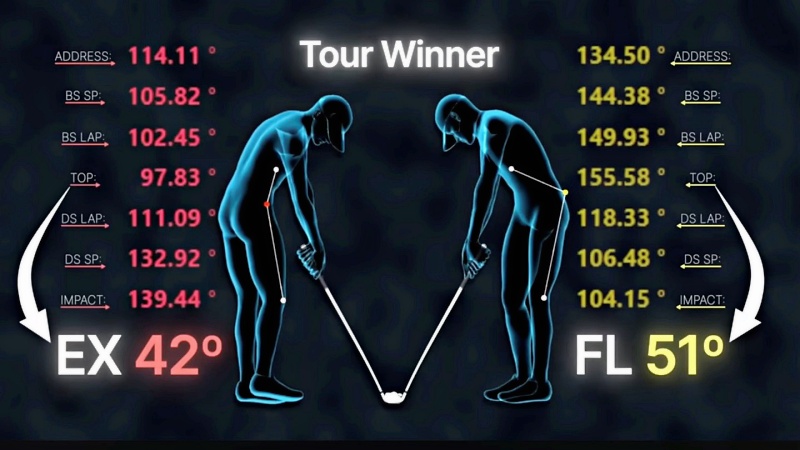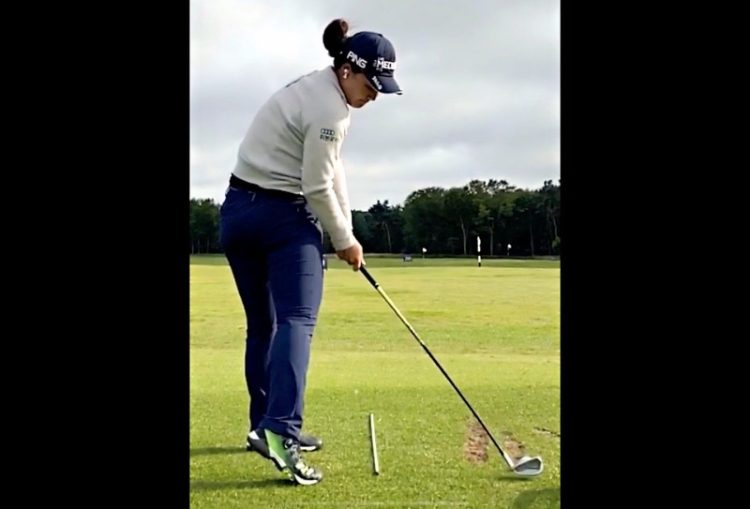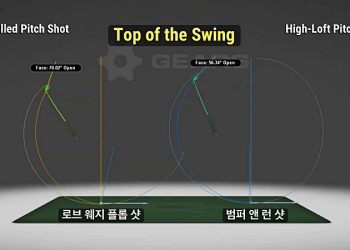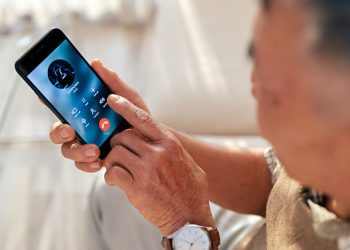장타를 치는 골퍼들의 공통된 특징이 있다. 임팩트 순간, 왼쪽 골반이 45도로 이동과 회전이 동시에 열린다는 점이다. 이는 몸의 체중 이동과 회전이 동시에 일어나기 때문인데 이런 동작이 일정하게 장타를 치는 기본이 된다.
먼저 어드레스 자세에서 발끝 선, 무릎 선, 그리고 허리 선을 목표로 향하게 한다. 백스윙은 왼쪽 어깨에 의해 진행된다. 백스윙이 제대로 되어야 이상적인 다운스윙을 이끌 수 있다. 하체 움직임은 최소화하고 상체만 회전시켜 몸을 완전히 코일 상태로 만든 후 다운스윙을 해야 한다.
다운스윙은 왼쪽 골반의 움직임에 의해 시작된다. 왼쪽 엉덩이 부분과 허리 부분이 함께 회전과 이동을 한다. 회전과 이동이 동시에 일어나게 만든다. 더 중요한 것은 이러한 몸의 움직임이 다운스윙 초기에 시작되어야 한다는 것이다.
어드레스 때 허리선을 중심으로 상체는 앞쪽으로 숙여진다. 왼쪽 허리 부분과 오른쪽 허리 부분이 같은 각도로 숙여져 있을 것 같지만, 실제로 3D 스윙 분석을 통해 자세히 보면 다르다. 오른쪽 굽힌 각도가 왼쪽보다 더 크다. 아주 작은 차이지만 오른쪽이 더 숙여져 있다는 것이다.
하지만 다운스윙이 시작되면 왼쪽 골반이 45도 사선으로 회전과 이동하게 된다. 왼쪽 사선으로 이동된 길이는 대략 10cm 전후가 된다. 이러한 동작을 시도할 때 대부분 숙여진 각도가 펴지게 된다. 소위 ‘배치기’라는 용어가 여기에서 나온다. 느낌상 더 숙여야 하고, 더 숙여진 각도에서 체중이 회전과 이동을 해야 한다.
 어드레스 때 숙여진 왼쪽 상체는 임팩트 시 더 숙여진 상태가 되어야 한다.
어드레스 때 숙여진 왼쪽 상체는 임팩트 시 더 숙여진 상태가 되어야 한다.
다운스윙 때 체중 이동 없이 몸을 바로 회전시키면 전혀 다른 스윙이 된다. 체중 이동은 샷의 거리를 증가시키는 데 큰 역할을 한다. 몸만 회전시키는, 소위 ‘몸통 회전 스윙’이라고 하는 스윙에 대한 잘못된 인식이 없었으면 좋겠다. 체중 이동 없이 회전만 강조하는 스윙은 당겨 치거나 밀어 치는 동작으로 연결된다.
임팩트 순간 양 무릎도 중요한 관찰 포인트다. 특히 오른쪽 무릎은 어드레스 때와 다운스윙 진행 중의 위치를 이해할 필요가 있다. 다운스윙 시 몸의 이동과 회전을 시도하면서 오른쪽 무릎이 볼 쪽으로 이동하며 튀어나오는 동작을 종종 보는데, 이는. 왼쪽 골반에 의해 다운스윙이 진행되면 쉽게 고칠 수 있다. 다운스윙 시 왼쪽 골반이 숙여진 각도보다 더 숙여진 상태를 유지하며 진행하면 해결될 수 있다. 오른쪽 무릎이 튀어나올수록 샷은 오른쪽으로 더 많이 날아간다.
이상의 내용을 3D 모션으로 분석하면 자세한 수치로 확인 할 수 있다. 우승한 PGA 투어 프로들은 어드레스 시 왼쪽과 오른쪽의 상체 숙여진 각도는 대부분 상상했던 것보다 큰 차이가 있다. 그들의 평균 수치를 보면 어드레스 시 우측 숙여진 허벅지와 상체 각도는 114.11도이며, 왼쪽은 134.50도로 덜 숙여져 있다. 하지만 스윙이 진행되면서 탑 동작에 다다르면 오른쪽은 97.83도로 아주 강한 코일 상태가 형성되었음을 알 수 있다.
반면, 왼쪽은 155.58도로 백스윙이 진행되면서 상대적으로 펴지게 된다. 하지만 결정적으로 다운스윙 시 왼쪽 골반의 체중 이동과 회전이 일어나면서 왼쪽의 숙여진 각도는 104.15도로 탑에서보다 51도 깊숙이 숙인 상태로 임팩트가 형성됨을 볼 수 있다. 오른쪽은 139.44도로 덜 숙여진 상태로 임팩트가 되고 있다.
▶동영상 보기
☞ 전욱휴는…
서울대 졸업 후 미국에 유학, 1996년 PGA 클래스A 프로가 됐다. 이후 28년만인 2024년 전세계 골프계 최고 권위의 ‘PGA 마스터 프로페셔널’ 자격을 획득했다. SBS, MBC, JTBC, YTN 등의 골프 채널 진행자 및 해설자로 활약했고, 지금은 애틀랜타와 한국을 오가며 골프 레슨 및 골프 관련 비즈니스를 하고 있다. chungolf@gmail.com
[Dr.Eric Chun’s Golf Lesson] 33. During the downswing, the left hip should rotate and shift 45 degrees simultaneously.
The forward-leaning angle of the left side of the torso should be greater than at the address position
Golfers who hit long drives share a common trait: at the moment of impact, the left hip opens with a simultaneous rotation and shift of 45 degrees. This movement occurs because the body’s weight shift and rotation happen at the same time. It serves as the fundamental basis for consistently achieving powerful drives.
First, during the address position, the lines formed by the toes, knees, and hips should be aligned with the target. The backswing is initiated by the left shoulder. Completing the backswing is crucial to setting up an ideal downswing. The lower body’s movement should be minimized, while only the upper body rotates to create a fully coiled state before the downswing begins.
The downswing starts with the movement of the left hip. The left hip and waist rotate and shift in unison, creating simultaneous rotation and movement. More importantly, this motion must begin at the very start of the downswing.
At the address position, the upper body leans forward around the waistline. Although it may appear that the left and right sides of the waist are bent at the same angle, detailed analysis through 3D swing motion reveals otherwise. The right side is bent at a greater angle than the left. While the difference is minimal, the right side is indeed more tilted. However, once the downswing begins, the left hip rotates and shifts diagonally at a 45-degree angle. The length of this left diagonal movement is approximately 10 cm. When attempting this motion, the initial forward bend often straightens. This phenomenon is commonly referred to as “hip thrust.” The sensation should be to lean forward more, maintaining that bent angle as the weight shifts and rotates.
If the body rotates without weight transfer during the downswing, the result is an entirely different swing. Weight transfer is crucial for increasing the distance of the shot. The so-called “torso rotation swing,” which emphasizes only rotation without weight transfer, is a misconception that should be avoided. Such a swing can lead to shots being pulled or pushed.
The position of both knees at the moment of impact is another important point to observe. In particular, understanding the right knee’s position during the address and throughout the downswing is necessary. During the downswing, as the body attempts to rotate and shift, the right knee often moves toward the ball and pushes outward. This issue can be corrected if the downswing is led by the left hip. Ensuring that the left hip remains more bent than it was at the address can help prevent this. The more the right knee pushes forward, the more the shot tends to veer to the right.
Analyzing the above through 3D motion analysis provides detailed numerical evidence. The average measurements of PGA Tour winners are as follows: The upper body’s forward-leaning angles on the left and right sides during the address position show a greater difference than one might expect. At the address, the angle of the right thigh and upper body is 114.11 degrees, while the left side is less bent at 134.50 degrees. However, as the swing reaches the top, the right side forms a powerful coil at 97.83 degrees. Conversely, the left side straightens to 155.58 degrees during the backswing. Critically, during the downswing, as the left hip initiates weight transfer and rotation, the left side’s angle becomes 104.15 degrees, 51 degrees deeper than at the top, forming the impact position. The right side, in contrast, becomes less tilted, measuring 139.44 degrees at impact.



















![[전욱휴의 골프 레슨] 46. 배치기(얼리 익스텐션)](https://www.atlantajoongang.com/wp-content/uploads/2025/03/photoKakaoTalk_20250306_073237889_01-350x250.jpg?v=1741361116)
![[전욱휴의 골프 레슨] 45. 임성재 '행온페이드' 샷](https://www.atlantajoongang.com/wp-content/uploads/2025/02/collage1-350x250.jpg)
![[전욱휴의 골프레슨] 44. 일관된 샷을 원한다면](https://www.atlantajoongang.com/wp-content/uploads/2025/02/QKakaoTalk_20250212_065748485-350x250.jpg)

![[전욱휴 골프 레슨] 42. 오른쪽 팔꿈치 역할](https://www.atlantajoongang.com/wp-content/uploads/2025/01/qQ1KakaoTalk_20250130_072058648-350x250.jpg)
![[전욱휴의 골프 레슨] 41. 매킬로이 파워 스윙](https://www.atlantajoongang.com/wp-content/uploads/2025/01/qQ1KakaoTalk_20250122_123635940-350x250.jpg)

![페리미터몰 정문. [홈페이지 캡처]](https://www.atlantajoongang.com/wp-content/uploads/2024/11/페리미터몰-75x75.png)




